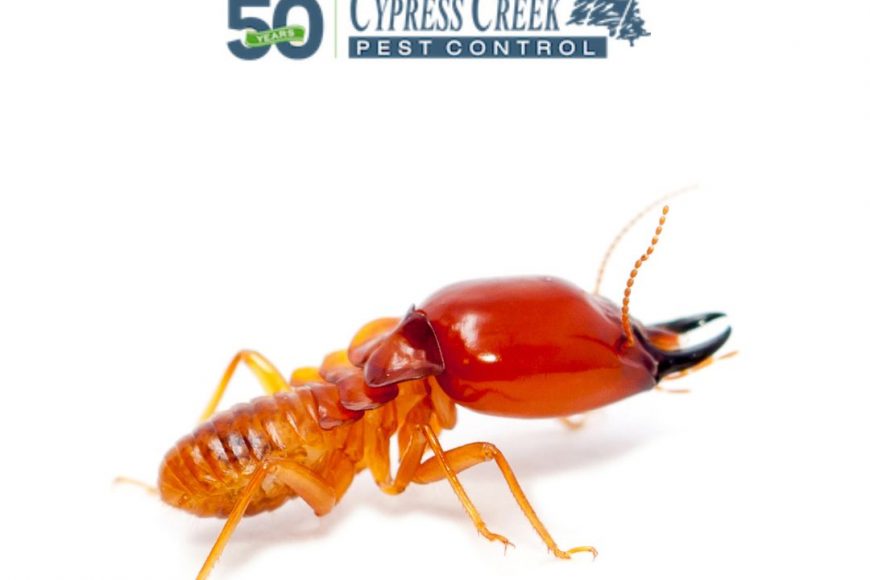Fill out the form below and a Cypress Creek representative will be in touch with you about your pest control needs.
BLOG

Uncovering the Termite Species in Houston: A Guide to Identifying and Treating Infestations
Termites are notorious for causing destruction to homes and businesses, and Houston is no exception. In fact, Houston is considered to be a high-risk area for termite infestations due to its humid climate and abundance of wood-based structures. With over 45 species of termites in the state of Texas alone, it’s important to know which species are prevalent in Houston and how to identify and treat them.
In this article, we will explore the different types of termite species in Houston, their behavior patterns, and the signs of infestation. We will also provide tips on prevention and treatment to help you protect your property from these destructive pests.
The Most Common Termite Species in Houston
- Subterranean Termites Subterranean termites are the most common species of termites in Houston. They are known for building elaborate mud tunnels that allow them to travel undetected from the soil to the wooden structure of a building. These termites feed on cellulose-based materials, such as wood, and can cause extensive damage to a building in a short amount of time.
- Drywood Termites Drywood termites are another common species found in Houston. Unlike subterranean termites, they do not require contact with the soil and can infest dry wood structures, such as attics and walls. Drywood termites are known for their ability to create kick-out holes in wood, which they use to dispose of their fecal matter. These holes can be a sign of infestation and should be inspected by a professional.
- Formosan Termites Formosan termites are an invasive species that have been causing damage in Houston since the 1960s. They are known for their ability to build large colonies that can contain millions of individuals. Formosan termites are also more aggressive than other species and can cause extensive damage to a building in a short amount of time.
Signs of Termite Infestation
Identifying a termite infestation early is key to preventing extensive damage to your property. Here are some signs to look out for:
- Mud tubes or tunnels near the foundation of your building
- Discarded wings near windowsills or doors
- Termite droppings or frass, which resemble sawdust or coffee grounds
- Hollow sounding wood or buckling floorboards
- Visible termite swarms or mud nests
If you suspect that you have a termite infestation, it’s important to contact a professional pest control company immediately. They can provide a thorough inspection of your property and recommend treatment options based on the type and severity of the infestation.
Prevention and Treatment of Termite Infestations
Prevention is key when it comes to termite infestations. Here are some steps you can take to protect your property:
- Eliminate moisture sources around your property, such as leaky pipes or standing water
- Remove any wood debris or stumps from your yard
- Seal any cracks or gaps in your building’s foundation or walls
- Install screens on windows and doors to prevent termites from entering
- Use pressure-treated wood for any new construction or renovations
If you already have a termite infestation, treatment options include:
- Liquid termite treatments, which involve applying a liquid pesticide around the foundation of your building
- Baiting systems, which involve placing bait stations around your property to attract termites and then eliminating the colony
- Fumigation, which involves covering your property with a tent and fumigating it with a gas to eliminate the entire termite colony
The best course of action for treating a termite infestation will depend on the type and severity of the infestation. It’s important to work with a professional pest control company to ensure that the treatment is effective and safe for your family and pets.
FAQs
Q: How do I know if I have termites in my house? A: Look for signs such as mud tubes or tunnels, discarded wings, termite droppings or frass, hollow sounding wood or buckling floorboards, and visible termite swarms or mud nests. It’s also a good idea to have a professional inspection done to confirm whether or not you have a termite infestation.
Q: How do I prevent termites from infesting my property? A: Eliminate moisture sources, remove wood debris or stumps from your yard, seal cracks or gaps in your building’s foundation or walls, install screens on windows and doors, and use pressure-treated wood for new construction or renovations.
Q: Can I treat a termite infestation myself? A: While there are DIY treatments available, it’s recommended to work with a professional pest control company to ensure that the treatment is effective and safe for your family and pets.
Termites are a serious threat to homes and businesses in Houston, and it’s important to know which species are prevalent in the area and how to identify and treat infestations. By taking preventative measures and working with a professional pest control company, you can protect your property from the destructive effects of termites. Remember, early detection and treatment are key to minimizing damage and saving you time and money in the long run.

